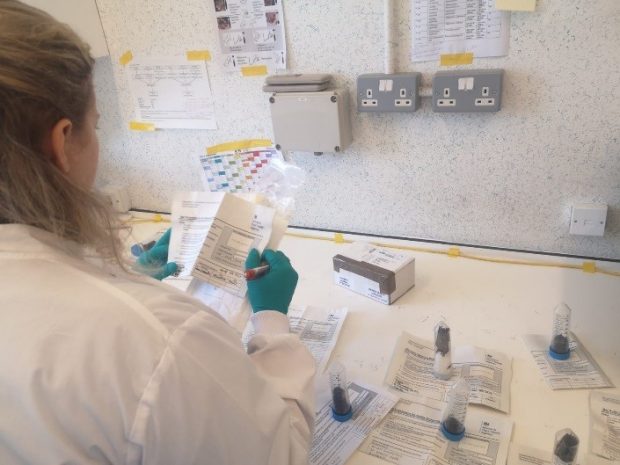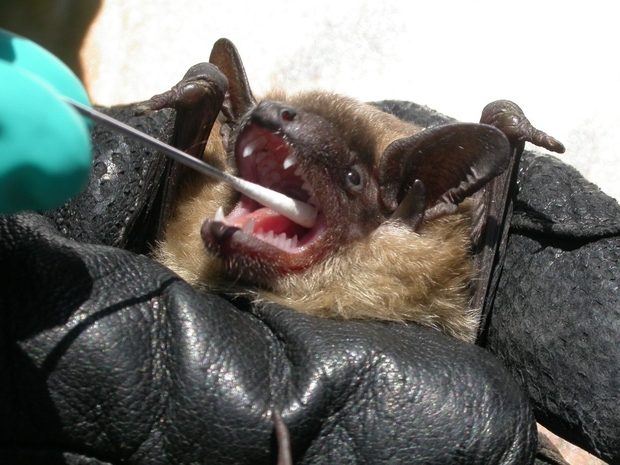When you hear the word Rabies, this often conjures up images of aggressive dogs, with drooling saliva dripping from bared teeth however, I imagine you would not necessarily think of bats as likely animals to become infected with the disease too?
In the UK, we are fortunate enough to have 18 species of bat and out of those, only a couple have been found to carry viruses capable of causing rabies called European Bat Lyssaviruses (EBLV).
Thankfully though, our winged friends like to keep their distance from us humans, even when they share the same building, making it unlikely that you will ever be in direct contact with a bat and be infected via a bat scratch, lick or bite. These beautiful creatures are best observed from a distance if you are lucky enough to spot one!
An increase in bat rabies cases
The Rabies Team at APHA has had an incredibly busy year. We reported 10 bat rabies cases in 2018, which is a record number compared to previous years. Previously, there were only one or two cases of bat rabies a year in Great Britain and all of these cases were in Daubenton’s bats infected with European Bat Lyssavirus Type 2 (EBLV-2). Of the 10 cases last year, eight of these were EBLV-2 infections (in Cambridgeshire, East Sussex, West Lothian and Northumberland). However, two cases were the first detection of European Bat Lyssavirus Type 1 (EBLV-1) in serotine bats in Great Britain.
The two serotine bats were submitted by a dedicated bat carer in Dorset who receives sick and injured bats from members of the public. There have subsequently been a further three EBLV-1 infected serotine bats detected this year, all submitted from the same lady in Dorset!

APHA rely on bat carers and members of the public to submit dead bats to our bat surveillance project, using our dedicated ‘Bat Packs’ containing a tube, submission form, jiffy bag and prepaid postage label. These are available from The Bat Conservation Trust, see their website for further information on the APHA Surveillance programme.
Since 1987 we have received more than 17,000 bats but only 28 have been infected with EBLV-1 (5 cases) or EBLV-2 (23 cases).
Both EBLV-1 and EBLV-2 are known to have caused four human deaths following bites from infected bats, including the death of a bat conservationist in Scotland in 2002. A small number of other mammals (cats, sheep and a stone marten) have also died of EBLV-1 infection in mainland Europe.

Although the UK is officially ‘rabies-free’, we will soon start a Defra funded study with our Wildlife Team to investigate whether EBLV-1 has recently infected serotine bats in England or if it has been present but at undetectable levels.
UK Reference Laboratory for Human Rabies
APHA is also the National Reference Laboratory (NRL) for human rabies, and provides a diagnostic service to clinicians and public health colleagues whenever rabies is suspected in the UK. There have been six cases of imported human rabies in the UK since 2001 in patients bitten whilst they were abroad in Asia or Africa.
Last year we were called upon to test for the disease in a British resident bitten by a rabid cat whilst on holiday in Morocco. We successfully provided confirmation of rabies on ante-mortem material (serial saliva samples and nape of the neck skin biopsy), negating the need for a post-mortem investigation which would have been against the family’s wishes on cultural grounds.
International work
As part of our remit as an OIE (World Animal Health Organisation) reference laboratory and WHO (World Health Organisation) Collaborating Centre for rabies, we have continued to contribute to international outreach programmes in countries where rabies is present to promote quality assurance and standardised methods for rabies diagnosis.
One of our more interesting projects to help other laboratories learn about our tests was when we became ‘film stars’ for the day in creating a video accompanied by a published protocol in the Journal of Visualized Experiments (JoVE). Be sure to visit the APHA Science blog site again soon to read our upcoming blog about this exciting process!
Vaccinate to eliminate
This year, the focus of World Rabies day is ‘Vaccinate to Eliminate’, aimed at raising awareness of rabies to promote pre-immunisation of dogs (to protect and control the disease) and post exposure immunisation (to prevent the disease in humans).
Governments across the world are being asked to commit to the goals set by the human and animal health international governing bodies to eliminate human deaths from canine rabies by 2030.
Vaccinating your dog against rabies is very important not only for the health of your pet but also to protect against transmission of the disease to humans. Of the many thousand cases of rabies associated deaths in humans, the overwhelming majority are as a result of dog bites.
What should I do if I suspect rabies in a bat?

It is possible, although rare, for a bat infected with rabies to also pass the disease on to humans or other mammals. Free vaccination is available to everyone bitten, scratched or licked by a bat in Great Britain. If you are bitten by any animal whilst abroad, seek medical attention immediately. Do not wait until you return home.
We have recently updated our guidance on rabies in bats and you may like to read what you should do if you find a dead bat or suspect rabies in bats.
Rabies in bats is a notifiable animal disease and if you suspect it you should report it immediately by calling:
- 03000 200 301 (Defra Rural Services helpline) in England
- 0300 303 8268 (APHA Field Service) in Wales or
- your local APHA Field Service Office in Scotland:
- Ayr 03000 600703
- Galashiels 03000 600711
- Inverness 03000 600709
- Inverurie 03000 600708
- Perth 03000 600704
Enjoyed reading? Then why not subscribe to the APHA Science Blog

1 comment
Comment by Susan Lamb posted on
Auntie Susan says Megan looks really important and doing fantastic work.